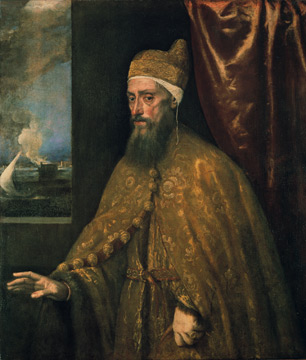Patricians and patrons
Even if portraiture is generally considered a minor genre as compared with religious and mythological painting, it enjoyed a particular status in Venice. The prerogative of the ruling classes (patricians, the wealthy, merchants, the well-educated), it was a way of showcasing the ancientness of one’s lineage and the importance of one’s office (doge, procurator, admiral), as well as being a means of moral edification.Of all Venetian artists, Titian was probably the most sought-after. Being painted by him was a mark of distinction which put you on a level with Pope Paul III, Emperor Charles V, King Francis I, Cardinal Ippolito de’ Medici, the dukes of Urbino and Mantua, or the doges.
In Venice, ancientness of family line was the precondition for the noble patriciate and the exercise of power. Portraits afforded a representation of the ancestral lineage and a reassertion of the right to a seat in the Grand Council.
Working life was of quite particular significance in Venetian society, and portraits would show their models in the execution of their duties. Moreover, it was important to depict glorious feats, military, diplomatic, or intellectual prowess not only as the fruit of individual genius but rather as appertaining to the excellence of the Republic of Venice. The large number of portraits displayed in public institutions also bolstered the notion of the changeover of political power—no single family had the monopoly on power, which was the preserve of the entire patriciate.
The main thing was that a portrait should be plausible rather than illusionary. It was not an image of reality but of how the subject wished to appear (morally great, cautious, able to control his passions, etc.), of the way he wanted people to see him.
Dress and attributes would reveal a man’s rank and office. Attire was even more important for women than men, given their lack of public activity. The Venetian authorities even had to bring in laws to regulate extravagant expenditure—costumes and finery were not to exceed a certain price fixed by the Republic, and luxury was to be tempered with self-restraint in appearance (laced-up corset, braided hair) and poise in gesture and demeanor that set female patricians apart from courtesans, who were not bound by such reserve.
The subjects were not always depicted within a specific setting. In Titian’s work in particular, the models stand out against a dark ground. Yet the setting—a window looking out on a landscape or an interior furnished with columns and seats—often tells us something about the figure’s public life. The window motif is generally absent from female portraits, in which the model stands out against an indeterminate ground or interior, thus reinforcing the idea that a woman’s social position lay within her home and family.







